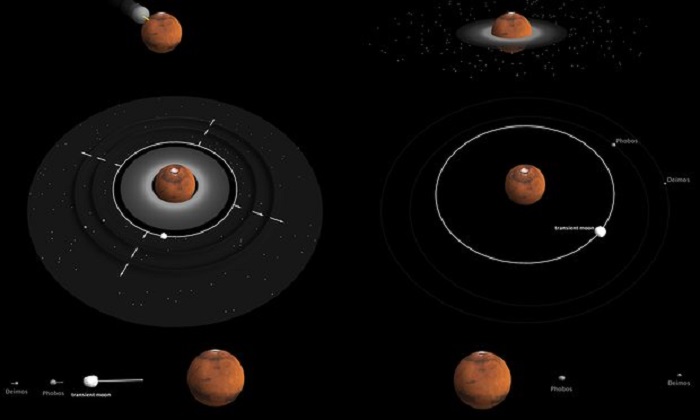With their odd shapes and diameters of just 22km and 12km respectively, Phobos and Deimos, some scientists argue, are asteroids that were captured by Mars. But others say the nature of their orbits makes that unlikely, suggesting instead that the moons formed in the region surrounding Mars, potentially after a collision between the planet and an enormous object. A similar event formed the Earth’s moon around 4.5bn years ago.
Such an impact on Mars would have hurled out debris while leaving the planet itself with a huge dent, potentially explaining the vast northern lowlands of Mars known as the Borealis basin.
But the case for a collision has perplexed researchers. It is not clear how it could have led to the formation of two very small moons, given the huge amount of material ejected and its sparsity in the region in which Phobos and Deimos would have formed.
Now scientists say they have come up with an answer: the impact led to the formation of at least one large moon which aided the birth of Phobos and Deimos before spiralling back into Mars.
“The trick is that this moon, which has played a major role in the process, has now disappeared,” said Pascal Rosenblatt, first author of the research from the Royal Observatory of Belgium.
Writing in the journal Nature Geoscience, researchers from Belgium, France and Japan reveal how they used computer simulations to explore possible scenarios for the formation of the moons of Mars following an impact.
The results, the authors reveal, suggest that the impact would have flung out a vast quantity of debris that eventually formed a disk. The inner regions of the disk, where the majority of the material ended up, could have given rise to at least one large moon with a diameter of around 200km.
By contrast, the small quantity of material in the outer regions of the disk would have been spread too sparsely to form Phobos and Deimos, instead potentially forming several very small “embryo satellites”. But the gravitational influence of a large moon, the authors say, could have led to these bodies clumping together resulting in the two moons of Mars we see today.
The large moon itself, however, was doomed. Unlike Earth, early Mars was spinning slowly relative to the orbit of its large moon. As a result, while Earth’s moon is spiralling outwards, the tidal forces of Mars would have dragged its large satellite inwards.
The upshot was that 5m years after its formation, the large moon of Mars would have fallen back into the planet. “It would have broken into very small parts that could in fact burn through the atmosphere or create very, very small impact craters,” said Rosenblatt.
It’s a fate that is awaiting Phobos, too. At just 6,000km from the surface of Mars, Phobos is set to fall back into the planet and disintegrate, with its demise expected to occur within the next 20 to 40m years.
Rosenblatt and the team say they are looking forward to the launch of missions including the Japanese Martian Moons Exploration, which will study the two moons and collect samples from Phobos. If the moons are found to have a composition similar to that of Mars, says Rosenblatt, it would support idea that they formed following a collision. Another possibility is that traces of the large, ill-fated moon could be found across the surface of Mars.
Benjamin Black, a planetary scientist at the City University of New York, saysthe possibility of testing the new theory is exciting.
“This research is important because it suggests we may still have a lot to learn about how moons form and evolve, even on our closest planetary neighbours,” he said. “It also underscores how quickly and dramatically planetary systems can evolve early in their history.”
More about:
















































